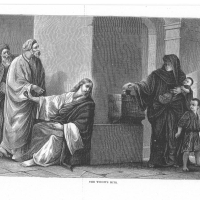Rich Americans Give Smaller Percentage of Income to Charities
 The Widow's Mite
The Widow's Mite
In the gospel story of the widow’s mite, a poor widow’s donation of her last two pennies earns far more praise than the extravagant donations of the rich because the widow kept nothing for herself while the wealthy held back plenty for themselves. According to a study of charitable giving published last week, things haven’t changed much in 2,000 years, as rich Americans donate a much smaller portion of their income—and an even smaller portion of their wealth—to charity than those less fortunate.
The study found that Americans who earned $50,000 or more in 2008 and itemized their deductions donated a median of 4.7% of their discretionary income to charitable causes, and that middle class Americans give a far larger share of their discretionary income to charity than the rich. Households earning $50,000 to $75,000 give an average of 7.6%, while those making $100,000 or more give only 4.2%, and rich people living in wealthy enclaves like gated communities give only 2.8%. Apparently, the wealthy are a bad influence on one another.
The study also found that tax incentives matter to charitable giving. In addition to the federal income tax deduction for charitable giving, at least 13 states offer their own special tax benefits. In Arizona, for example, charities are gaining more than $100 million a year from tax credits adopted in recent years.
Religion strongly influences charitable giving. The more religious regions of the U.S. give more to charity—but only if one counts all donations to religious organizations as gifts to charity. Two of the top nine states—Utah and Idaho—have high numbers of Mormon residents, who traditionally give at least 10% of their income to their church, and the remaining states in the top nine are all in the Bible Belt. Yet much of what organized religion does has little to do with charity and more to do with institutional self-preservation and even political activity. In 2008, for example, giving to the Mormon Church spiked while it was playing a crucial role in passing a California ballot measure banning gay marriage.
When religious giving isn’t counted, the geography of giving nearly reverses itself, as New York jumps from No. 18 to No. 2, and Pennsylvania climbs from No. 40 to No. 4. Similarly, the greater generosity of so-called “Red” states, which tend to vote Republican, compared to “Blue” states that vote Democratic also disappears when religious giving is excluded.
-Matt Bewig
To Learn More:
America’s Generosity Divide (by Emily Gipple and Ben Gose, Chronicle of Philanthropy)
- Top Stories
- Unusual News
- Where is the Money Going?
- Controversies
- U.S. and the World
- Appointments and Resignations
- Latest News
- Musk and Trump Fire Members of Congress
- Trump Calls for Violent Street Demonstrations Against Himself
- Trump Changes Name of Republican Party
- The 2024 Election By the Numbers
- Bashar al-Assad—The Fall of a Rabid AntiSemite






Comments